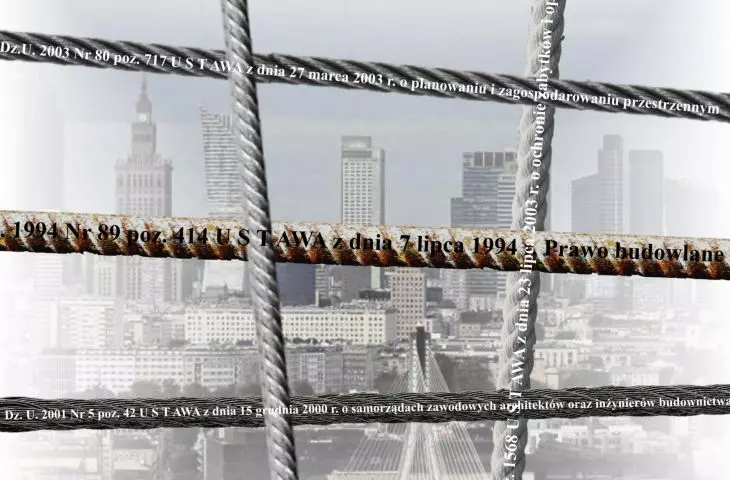A proverb or maxim "the truth will set us free" (it is a slightly modified Gospel quotation "know the truth and the truth will set you free" [John 8:31-42]) has been floating around in the social circuit, and from time to time in the media. Since it sounds wise and philosophical, it is not at all uncommon to invoke it in disputes and discussions. We in the architectural community use it very rarely or not at all, however, we have paraphrased it to a certain extent, as you may think. It has never been formulated expressis verbis, but it would probably read "procedures will set us free."
In all discussions, articles, columns, speeches at seminars or conventions, there is a constant complaint about the regulations in force in our country concerning broadly defined policy, land use, architecture and all the formal and legal surroundings related to these issues. For years there has been a belief that the healing of the legislative system, together with the procedures contained therein, will provide a breakthrough in the shaping of our space and take it to a different, definitely higher quality level.
To some extent, this belief is confirmed by the fact that more than half of the questions on the examination for licenses in the Chamber of Architects of the Republic of Poland cover procedures, even though, in view of the permanent changes in legislation, this knowledge devalues after three or four years. Is it really the case that formal regulations at the level of laws and ordinances are or will be an effective remedy to stop the progressive spatial chaos in our country? Or is it quite the opposite? It is spatial chaos as a desired state that is reflected and sanctioned to some extent by complicated, inconsistent, convoluted and often contradictory statutory regulations? Such are the regulations, what is the will, even hidden, to obtain the goals. It should be remembered that legal regulations arising from democratic procedures can also be negative by design, not to mention the fact that lawmaking and law application are completely separate worlds. Even the best regulations, when misapplied, produce the worst results. This should serve as a warning against blind and uncritical faith in the effectiveness and rightness of even democratically legislated procedures.
pitfalls of legislation
© Piotr Średniawa
However, while in the procedures themselves unsupported by real action it is difficult to expect, in the absence of will, really significant change and improvement in the quality of the space, the sequence of introduction of bad procedures certainly worsens this condition. This is no revelatory truth. It is enough to trace the legislative actions of the Polish magnates and nobility in the 17th and 18th centuries effectively blocking the development of cities, in contrast to European countries. Poland's still poor level of urbanization today has its origins, among other things, precisely in the regulations of more than three hundred years ago. I guess as a society we have fallen into a space-time loop straight out of sci-fi movies, from which we can't get out, we get bogged down in this loop of chaotic and ad hoc lawmaking concerning our space, without understanding how lasting the effects of such actions are. It is necessary to identify the real, although sometimes not fully defined, problems and causes of such a bad state of our space, the poor conditions of execution, the progressive degeneration and marginalization of our profession.
unclear goals
So it's worth looking at the ideas, or perhaps quasi-ideas, in our spatial policy, even if they were never explicitly pointed out and articulated. After the complete rejection after 1989 of planning, including spatial planning, as a supposedly discredited and oppressive tool of the communist system, piecemeal efforts were slowly built from scratch. Although the goals and objectives of such a "spatial policy" were never explicitly indicated, after more than thirty years it is possible to point out to some extent these intentionally or accidentally created tendencies, but also pathologies.
- The complete primacy of property and private interest over social and public interest.
- The sources of this state of affairs should be sought in the adoption of the neoliberal doctrine of political transformation after 1989. To some extent, such orthodox primacy of property and private interest was probably due to the fact that in Poland we had no case of re-privatization, but a completely new privatization process, in the initial period, but also in later phases based on the dubious actions of nascent capital. The protection of these interests was to be ensured by the primacy and dictates of the newly created private property. However, the dogma adopted at the time was never verified.
- According to the neoliberal doctrine, a chaotic, haphazard and logicless privatization of urban volumes and spaces was carried out, making the city a mélange of different properties, difficult both to manage and to conduct a rational spatial policy.
- Maximum facilitation of investment for entities first foreign and now also native, without special requirements and restrictions, resulting in "flexibility" and "openness" of drawn up MPZPs or client-oriented WZiZTs. As a result of such actions, the effectiveness of local governments in creating the quality of space was and is completely illusory.
- Shifting to the investor all the procedures of the investment process, from obtaining a survey map, ensuring the supply of utilities, to carrying out all sorts of arrangements blown out of proportion, etc. Thus, the state has taken on the role of a pseudo-controller of procedures, rather than a creator of spatial policy.
- Urban planning has languished in favor of spatial planning, increasingly drifting toward non-spatial, even paraliterate strategies, such as the concepts of the smart city, the innovative city, the city of science, the multicultural city, or the introduction of categories of urban competitiveness.
- Since accession to the EU and the gradual influx of EU funds into Poland, planning has been treated mainly in short-term terms. The goal was to obtain and allocate as much EU funds as possible for investment, without defining synergies (on a regional or national scale) and setting long-term or even medium-term goals.
These phenomena and trends, which have been created and operating for more than thirty years, have contributed to an increasing planning vacuum, both in the substantive area and in planning and urban planning practice, reducing it to sterile procedures devoid of content. As a result, the measures and tools constructed under the Planning and Urban Development Law have become completely formalized instruments with a purpose that is difficult to understand. Similarly, in the Construction Law and related ordinances that are to some extent derivative of planning regulations - it is difficult to identify any specific purpose they are intended to serve. In general, these are substantively "empty" laws. In none of the laws will one find a provision for the devastation or degradation of a space, landscape, street or building, except for historic buildings, as if only they, and not the remaining space, were of significant value. As a result, we have created a toxic triad entangled in procedures - investor, architect, official - in which it is not really clear who or whose interest is represented. Certainly not the public interest. This cannot be obscured by incantations about spatial order, sustainable development, green-blue urban infrastructure and similar self-satisfying platitudes obscuring our reality.
the slope of procedures
This illegible picture of spatial policy would seem to have become permanently established in our reality, and attempts to improve procedures are aimed not at changing it necessarily, but only at enabling it to move more smoothly. However, this permanent chaos, and chaos many times has the characteristics of permanent stability, has undergone significant changes in the last more than two years. The aforementioned liberalism is gradually being replaced by populism, which is equally detrimental to the shaping of space. The very poor results of the Mieszkanie plus program, the equally poor, and in many cases negative, effects of the "lex developer" speculative law, clearly indicate that attempts to launch a multifamily housing policy have failed to produce the expected results, as was predictable. As it seems, due to the fact that in the area of multifamily housing there is no chance of significant improvement, and on the contrary, due to the turmoil in the financial markets and the drastic increase in the cost of credit, the chance naively began to look for in individual single-family housing, thus flying the proverbial white flag over the state's housing policy. This time the opportunity (by no means, however, to achieve spatial order) is seen by those in power in the elimination of procedures, and in fact the full liberalization of procedures for single-family development. The area of single-family construction is already completely out of any planning control today. Hundreds of thousands of single-family houses under construction are effectively degrading the space of our country, and current procedures are completely ineffective in this regard. Meanwhile, instead of taking measures to strengthen the actual spatial planning of these developments and attempting to control the process, the procedures for obtaining permits for the construction of single-family buildings of up to 70 sq. m. have been abolished as of January 3, 2022. [you can read more about this here - editor's note] and launched a failed architectural competition for this type of development [you can find the results of the competition here - editor's note]. Unfortunately, this was only the beginning of a very dangerous process. In recent days, a project to introduce very radical changes to the Construction Law appeared on the pages of the Government Legislation Center. Without going into details, the changes consist of the fact that, as part of the continuation of the policy of simplification and deregulation of administrative proceedings for the construction of single-family houses, it is planned to completely eliminate the requirement to obtain a construction permit in favor of a notification without the possibility of objection in the case of the implementation of projects to meet one's own housing needs with a height of up to two stories. The possibility of executing single-family house projects by persons with so-called limited construction authorizations, i.e. engineers and construction technicians, has also been expanded. A catalog of recommended projects is also announced. In short, this will mean that without any more control and supervision by the administration, anyone will be able to start building a single-family house designed by people with questionable qualifications, or use catalog solutions. Despite the "packaging" of these regulations as expected and desired by the public, they effectively remove the much-needed discussion of the need for systemic regulation of spontaneous single-family construction. It should be made clear that the introduction of these populist regulations will not be a failure only of the current government team, the community of architects and urban planners, but of the entire society living now and, worse, also in the future, in an increasingly poorer quality space.
the pitfalls of legislation
© Piotr Średniawa
For more than thirty years, urban planning has been successfully eliminated in Poland, and now it is the turn of single-family housing. The question arises as to what element of our space will be the next area we devastate. The past system collapsed more than 30 years ago, but like déjà vu one gets the impression that some gloomy clouds of communism are still floating in our sky. It is worth mentioning the late Wojciech Mlynarski, who sang in 1971: "For one thought is going through their heads, which I will summarize like this: What else would we screw up here, Gentlemen? What else would there be?".
{tag:AuthorA&B}
Check out A&B's new section - Law in Architecture, where you'll find clear provisions of current laws and opinions of MPOIA experts and appraisers.




















